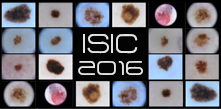
Wednesday, 13 April, 8:30am-12:15pm
Organizers
- E. Grisan (University of Padova, UK)
- M. Coimbra (IT Porto, PT)
- E. Trucco (University of Dundee, UK)
Clinical partners
- M. Dinis-Ribeiro (CINTESIS/ Faculdade de Medicina da Universidade do Porto and the Instituto Portugues de Oncologia, Porto, PT)
- C. Trovato (European Institute of Oncology, Milan, IT)
- S. Realdon (Veneto Institute of Oncology, Padova, IT)
- R. Leong (Bankstown and Concord Hospitals, University of New South Wales, Sydney, AU)
- M. Häfner (Elisabeth Hospital, Wien, AT)
Challenge website
Challenge abstract
The increase incidence and burden of gastroenterological diseases, challenges both the surveillance strategies and resources for monitoring at risk patients and the possibility of early detection and accurate staging of lesions and tissue alterations. The need to relieve the clinicians and health system of part of the bottlenecks commonly found in endoscopic surveillance, and to reduce the number of unnecessary biopsy taken from the patients, has asked for an ever increasing effort from the imaging community to provide to the endoscopists tools to the able to identify suspicious areas, suggest bioptic sites, perform a virtual histology, or estimate the tissue diagnosis.
The aim of this challenge is to bring together the community of researchers working on the various types of optical endoscopy at its multiple scales and different needs, to provide reference databases and reference results both for the imaging community and those interested in the translation to the clinical practice. The strength of this challenge is the variety of endoscopic data that are going to be continuously accrued as more clinical centers agree in sharing their data.
The challenge is divided into different sub-challenges, providing datasets spanning from the microscopical scale of the confocal endoscope to the wide field level of chromoendoscopy, and addressing needs going from the virtual histology to the segmentation of salient regions to the computer aided diagnosis.
Other challenges
 |
Cancer Metastasis Detection in Lymph Nodes (CAMELYON) |
 |
Skin Lesion Analysis towards Melanoma Detection |
 |
Lung Nodule Analysis (LUNA) |
